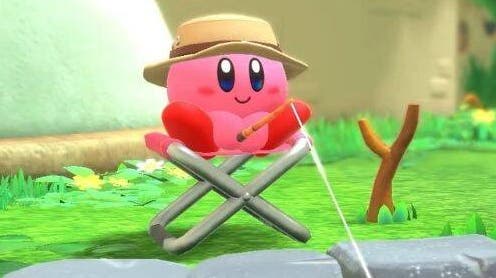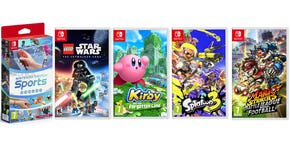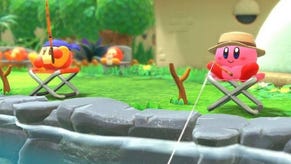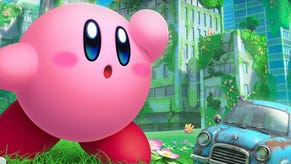Kirby and the Forgotten Land: a tech design revolution for the series
A Nintendo icon finally transitions to full 3D - and the game is excellent.
For Nintendo, the transition from flat-plane 2D gaming to a full 3D experience kicked off in earnest with Super Mario 64 - with most key franchises following suit in short order. Except one. The Kirby series remained on a side-scrolling path across the generations and while I adore side-scrolling games, I couldn't help but wonder how this series might play in full 3D. Now, we finally have some answers. Kirby and the Forgotten Land is the first fully 3D movement-based series entry and I love it.
Forgotten Land has players taking control of Kirby across a wide range of stages while platforming, flying and copying enemy abilities, much like prior games. However, the shift in perspective allows for a shake-up in its level design that is very welcome. It's still a retro style of game design but this new entry brings a lot of fresh ideas to the table with elements like the new 'mouthful' objects that directly influence mechanics.
The transition of Kirby's basic functions into the 3D space is challenging from a game design perspective, but the developers have done a good job. Take Kirby's flight ability, for instance. You want to keep levels constrained enough for game flow purposes - but restrict this ability too much and it loses that Kirby essence. Kirby's inhaling ability is also more difficult in 3D - on a 2D plane you basically engage this action while facing an enemy but in 3D, you need to consider all 360 degrees around the player. If it's difficult to suck up your foes, it would become frustrating - Nintendo hadn't really solved these issues in any comparable N64 games either.
With Forgotten Land, we finally have the chance to see this work and this is interesting to me as I think they've managed to strike a perfect balance here by relying on subtle auto-correction. Gulping foes, for instance, relies on an auto-positioning of sorts that just lightly guides you when pressing the button. Furthermore, while flight is fully intact, there are limitations on how long and how high you can fly. It still maintains that sense of freedom you expect but it's just constrained enough to keep you within each section. In that sense, I think the controls are perhaps the game's biggest triumph - the act of moving Kirby around feels great, and all of his actions are easy to execute in 3D.
Another key element is the camera system - most 3D cameras have shifted towards relying on the user to adjust angles via the right stick and this is great in most cases but for this title, HAL has opted to build custom camera tracks designed to keep the action framed while introducing some interesting angles. It's similar to Super Mario 3D World but more robust overall, I'd say. You can nudge the camera left and right with the stick, if you like, but it's generally not necessary and even in two player co-op, the game tracks you with ease.
This is a not a game pushing technical boundaries, but I do feel that the development team has crafted a beautiful overall experience with just a few caveats worth mentioning. So, firstly, image quality - this game features dynamic resolution scaling and in docked mode, it scales all the way up to full 1080p while lower bounds seem to hit around 810p or possibly lower in the worst case. Portable mode also scales dynamically but I find that it holds its 720p target more regularly with super sharp image quality - it looks superb on the Switch OLED in particular.
There is one issue I have with this, however - Nintendo remains allergic to anti-aliasing. Many of their first-party titles have opted for a raw pixel look which can work OK if the resolution is high enough and stable but with dynamic resolution scaling, it does result in more aliasing than I'd like. This is moderately offset by the heavy use of depth of field. This choice may not appeal to everyone, but I think it works here as it cleans up distant aliasing and shimmering and also lends the game an almost tilt-shifted appearance. Still, despite the lack of AA, I feel the art team has done a great job.

Art direction is excellent too: the game world is divided up into individual stages all based on a theme, primarily based around destroyed locations such as an abandoned mall, which is a true to delight to explore, or old subway tunnels. You select each stage from a beautiful world map that lets you fly around freely, highlighting the range of side-stages available as well.
Within the world, HAL has crafted surprisingly large and dense stages to explore. Each stage makes full use of shadow maps so both dynamic and static objects alike can cast shadows - the quality of these shadows is not always great, but it does lend the world extra depth. Compared to Super Mario 3D World, the amount of geometric and texture detail is ramped up significantly - it's a much more visually dense experience. In addition, HAL appears to be using a form of baked indirect lighting to create the impression of bounce lighting - nothing especially fancy, but the pre-calculated lighting in this game is very nice indeed.
But it's how the game looks in motion that is one of its greatest strengths - the animation work is simply superb. Kirby squashes and stretches with a vast array of animations; enemies move and react nicely and even incidental animations perfectly capture the spirit of the original games. The only issue is that animation frame-rate is determined by the distance from the camera, meaning lower update rates further into the distance. This can become rather distracting when large objects are moving around in the distance and is a minor blemish on an otherwise lovely game.
Ultimately, there's little in the way of new, cutting-edge tech here but it's a great example of how art design and a strong use of existing techniques can deliver a coherent, beautiful game. However, the density of the visuals does have an impact on performance. Nintendo's signature 60fps gameplay isn't in effect here, it's a capped 30fps instead and I'll be honest, when you look at what was achieved in Super Mario Odyssey, Bowser's Fury and Metroid Dread, it's not difficult to be slightly disappointed by the performance in this game. While I'm rather pleased with the presentation overall, this is one of the games that suggests we need a more powerful Switch as it deserves a higher frame-rate.
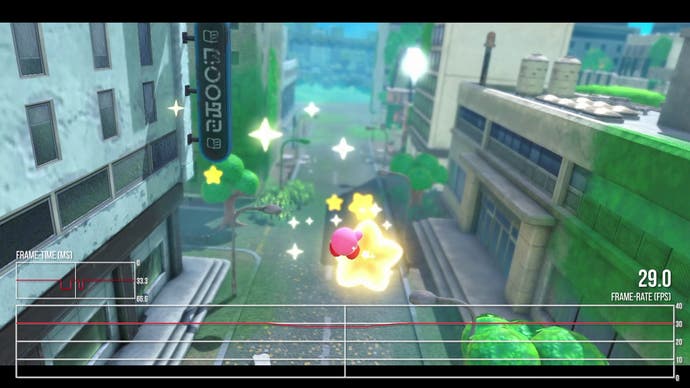
On the positive side, the major performance dips I saw in pre-release media are cleaned up and Kirby does deliver a very stable 30 frames per second. Dips can occur in select instances but it's uncommon. Furthermore, input latency is kept low so the game manages to feel responsive. I suppose I shouldn't be surprised by the performance given that Star Allies, the side-scrolling game released years ago in the Kirby series, also runs at 30fps despite lacking the scope of Forgotten Land.
The game's tech credentials are sound overall, but is this a good Kirby game? It's not always the case with this series, unfortunately, but in this case - the developers have pulled it off. This might be one of the best Kirby games to date and that comes down to two things - the level design itself and the power-up system.
Each world contains a handful of main stages and each stage has its own unique theme or concept. This results in a surprising amount of variety per level with unique puzzles and situations appearing as you play. The Mouthful mode plays a nice role in this - yes, Kirby swallowing a car makes for a funny visual gag but there are a lot of objects like this. You can fly. You can swallow a vending machine and fire cans of soda. You can drink from a pipe and become a water balloon that shoots liquid. There's even weird stuff like swallowing a locker and pulling it off the wall to figure out the answer to a puzzle. It's all weird but surprisingly fun and endearing.
Beyond this, the copy ability is still here and this time you can upgrade those abilities. The sword, for instance, can be upgraded to a much larger sword with a greater reach. Basically, all these ideas coalesce into something that I really enjoyed and is basically what I'm looking for in a 3D platformer these days. It's not going to revolutionise the genre but I don't feel it needs to - this is just solid platforming action with beautiful visuals and a fantastic soundtrack.
After covering so many triple-A heavy hitters over the past few months I really enjoyed having a chance to relax and hang out with Kirby this week. It's such a polished, complete game with a lot of heart that I think it deserves a shot if you're into this type of experience.
